
Essential Guide for Parents: 7 Must-Know Tips for Securing Your Home Network and Protecting Your Family Online
In today’s connected world, securing your home network is no longer just a tech-savvy task; it’s an essential step every parent should take to protect their family’s digital well-being. With children frequently online, managing smart devices, and sharing personal information, it’s crucial to ensure that your home network is secure from online threats. If you’ve been wondering, “How can I make our home Wi-Fi safe for my kids?”—you’re in the right place! This guide covers practical steps, from setting up a secure network to filtering content, so you can confidently safeguard your family’s online environment.
1. Understand the Basics of Home Network Security
Securing your home network may sound complex, but it starts with understanding the basics. Your home network is the link between all your devices and the internet. Without proper security, unauthorized users can potentially access sensitive information, or even control your devices. Think of it as the digital version of locking your doors at night—just essential!
Quick Tip: Start by ensuring your Wi-Fi network is password-protected. A strong password (at least 12 characters with a mix of numbers, letters, and symbols) adds a layer of protection against unauthorized access.
2. Use a Strong and Unique Wi-Fi Password
Many parents don’t realize that the default password on their router is often easily guessed. Change this default password to something unique and difficult to guess. A password like “Summer2023” may seem secure, but hackers often try common phrases. Instead, try something like “K!ds@Hom3NeTw0rk!”
Did You Know? According to a study, 41% of parents reuse passwords across devices, increasing the risk of security breaches. Changing your router password to a unique, complex password makes it significantly harder for unauthorized users to access your network.
3. Enable Parental Controls
Parental controls are essential for filtering out harmful content and setting limits on your children’s internet use. Many routers come with built-in parental controls, or you can use apps to customize content filtering and manage screen time.
Popular Tools:
- SecureHomeNetwork.org includes robust parental controls, allowing families to manage and monitor online content, set usage limits, and block inappropriate sites, ensuring a safe internet experience for children.
Setting these controls gives you peace of mind, knowing that your children are browsing the web safely without stumbling onto inappropriate sites.
4. Keep Firmware and Devices Updated
One often-overlooked aspect of home network security is firmware updates. Just like your smartphone, routers need updates to stay protected against the latest threats. Enabling automatic updates ensures your router has the latest security patches, reducing vulnerabilities.
Quick Fact: A study revealed that 60% of consumers don’t update their router firmware regularly, leaving them susceptible to malware attacks. Regular updates help you stay ahead of potential threats, protecting every device connected to your network.
5. Secure All Smart Home Devices
From smart TVs and gaming consoles to home assistants, each connected device is a potential entry point for hackers. Ensure every device uses a unique, complex password and that all devices are on a secured, encrypted network. It’s also a good idea to disable features like voice purchasing if your home assistants are accessible to kids.
Pro Tip: Set up a separate guest network for visitors and IoT devices like smart thermostats. This way, if a visitor’s device is compromised, it won’t affect your main network and devices.
6. Teach Your Kids Basic Online Safety
Educating your children about internet safety is a vital layer of home network security. Help them understand the importance of not sharing personal information online, being cautious with downloads, and avoiding suspicious links. This doesn’t need to be a lecture—games, apps, and interactive resources can help teach these lessons in a fun way.
Conversation Starter: “What would you do if someone asked for your name and where you live while you’re online?” Discussing scenarios with kids helps reinforce the importance of online safety in a relatable way.
7. Use a VPN for Extra Security
A Virtual Private Network (VPN) encrypts your internet connection, making it harder for hackers to intercept data. This is especially useful if family members use devices on public Wi-Fi or if you have older kids who frequently access the internet on multiple devices.
Recommended VPNs for Families:
Secure Home Pro: Our built in VPN connects you directly to our enterprise grade security platform, ensuring you are always protected.
VPNs add a layer of privacy, ensuring your family’s online experience.
8. Consider Secure Home Network’s SASE Platform: The All-in-One Security Solution
While implementing individual security measures is important, modern families can benefit from a comprehensive security approach. This is where Secure Home Network’s Secure Access Service Edge (SASE) platform comes in, offering an integrated solution that combines network security with ease of use.
What Makes SecureHomeNetwork SASE Special?
Complete Protection Package:
- Cloud-Based Security: Protects your family whether they’re at home or on the go
- Zero Trust Security: Verifies every connection attempt, ensuring only authorized access
- AI-Powered Threat Detection: Automatically identifies and blocks suspicious activities
- Real-Time Content Filtering: Adapts to new online threats as they emerge
Parent-Friendly Feature: The intuitive dashboard lets you monitor and manage all security settings from your smartphone, making it easy to adjust controls even when you’re away from home.
Key Benefits for Families:
- Unified Management
- Control all security settings from one dashboard
- Manage multiple devices and user profiles easily
- Set different access levels for different family members
- Advanced Protection
- Automatic threat blocking
- Phishing protection
- Malware prevention
- Safe browsing enforcement
- Smart Monitoring
- Real-time activity alerts
- Usage reports and insights
- Screen time management
- Application control
Did You Know? SecureHomeNetwork’s SASE platform blocks an average of 150 threats per household monthly, many of which traditional security methods might miss.
Easy Setup Process:
- Download the SecureHomeNetwork app
- Create your family profile
- Connect your devices
- Choose your protection level
- Start enjoying secure browsing
The platform grows with your family’s needs, allowing you to add devices and adjust security settings as your children get older or your home network expands. Secure in less than 10 minutes.
Conclusion
Securing your home network doesn’t have to be overwhelming. By taking a few straightforward steps, like updating your router’s firmware, setting up parental controls, and educating your kids about online safety, you can provide a safer internet experience for your family. For those seeking a more comprehensive solution, SecureHomeNetwork’s SASE platform offers an all-in-one approach to family online security, combining advanced protection with user-friendly management.
Each of these strategies is designed to offer peace of mind and protect what matters most—your family. Remember, cybersecurity is an ongoing process, so make it a habit to regularly review and update your home network settings.
By following these tips and utilizing modern security solutions like Secure Home Network SASE, you’re creating a strong foundation for digital safety in your household. Ready to get started? Secure your home network today and keep your family safe online!
